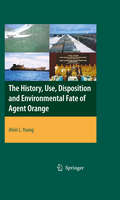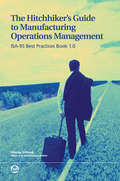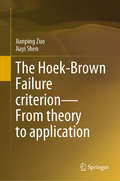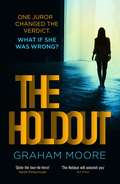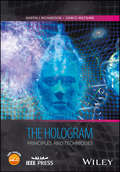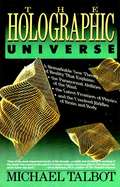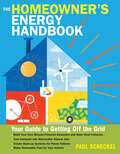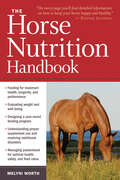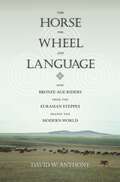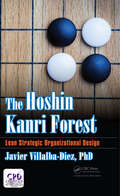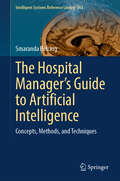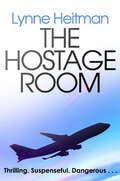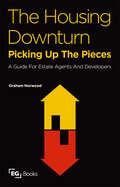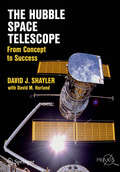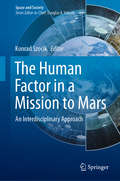- Table View
- List View
The History, Use, Disposition and Environmental Fate of Agent Orange
by Alvin Lee YoungFor almost four decades, controversy has surrounded the tactical use of herbicides in Southeast Asia by the United States military. Few environmental or occupational health issues have received the sustained international attention that has been focused on Agent Orange, the major tactical herbicide deployed in Southern Vietnam. With the opening and establishment of normal relations between the United States and the Socialist Republic of Vietnam in 1995, the time has come for a thorough re-examination of the military use of Agent Orange and other "tactical herbicides" in Southern Vietnam, and the subsequent actions that have been taking place since their use in Vietnam. The United States Department of Defense has had the major role in all military operations involving the use of tactical herbicides, including that of Agent Orange. This included the Department's purchase, shipment and tactical use of herbicides in Vietnam, its role in the disposition of Agent Orange after Vietnam, its role in conducting long-term epidemiological investigations of the men of Operation RANCH HAND, and its sponsorship of ecological and environmental fate studies. This book was commissioned by The Office of the Deputy Under Secretary of Defense (Installations and Environment) with the intent of providing documentation of the knowledge on the history, use, disposition and environmental fate of Agent Orange and its associated dioxin.
The Hitchhiker’s Guide to Manufacturing Operations Management: ISA-95 Best Practices Book 1.0
by Charlie GiffordDo you want to dramatically lower total cost of ownership (TCO) for manufacturing IT architectures and manufacturing, as well as reduce supply chain operational costs? The methodologies and technical applications presented in this first annual ISA-95/MESA Best Practices book will help get you started on the right track. This book provides in-depth coverage on how you can apply ISA-95, Enterprise-Control Integration Standard, to help lower TCO of manufacturing operations management (MOM) systems and their enterprise and plant interfaces. It consists of a series of related "how-to" white papers described in the context of ISA-95 models, definitions, and data exchanges. To be competitive, actual manufacturing operations activities must be highly interactive in supply chain and enterprise processes for effective collaboration and competition. This is the domain of collaborative and flexible MOM system architectures. This book explains the business cases for using evolving ISA-95 methods to effectively design, implement, change and optimize the MOM business processes and supporting MOM system architectures within the distributed pull supply chains.
The Hive Detectives: Chronicle of a Honey Bee Catastrophe (Scientists in the Field)
by Loree Griffin Burns Ellen HarasimowiczWithout honey bees the world would be a different place. There would be no honey, no beeswax for candles, and, worst of all, barely a fruit, nut, or vegetable to eat. So imagine beekeeper Dave Hackenburg's horror when he discovered twenty million of his charges had vanished. Those missing bees became the first casualties of a mysterious scourge that continues to plague honey bee populations today. In The Hive Detectives, Loree Griffin Burns profiles bee wranglers and bee scientists who have been working to understand colony collapse disorder, or CCD. In this dramatic and enlightening story, readers explore the lives of the fuzzy, buzzy insects and learn what might happen to us if they were gone.
The Hoek-Brown Failure criterion—From theory to application
by Jianping Zuo Jiayi ShenThis book provides a comprehensive coverage of the theory and principle of the Hoek-Brown (HB) failure criterion, methods or guidelines for estimating the HB input parameters, and the methodology of application of the HB criterion in rock engineering projects. It aims to help researchers, engineers and research students who work in the area of rock mechanics and mining engineering. Academics can quickly obtain an overview of the state of the art of the theory and principle of the Hoek-Brown criterion by reading the book before they advance their researches on the topics related to rock failure criteria. Geotechnical engineers can select appropriate Hoek-Brown input parameters for the design and analysis of rock engineering projects with the help of the principles introduced in this book. Research students may use the book as a textbook to learn the principle of rock mechanics related to rock mass properties.
The Holdout: The tense, gripping Richard and Judy Book Club pick for 2021
by Graham Moore'The most gripping and satisfying thriller I've read in more than a decade' Sophie Hannah'One of the best legal thrillers ... as elegant and gripping as Scott Turow's Presumed Innocent' Daily Mail'Quite the tour de force! Twelve Angry Men meets Chinatown and creates something of its own' Sarah Pinborough'This is a tense, emotionally charged, scary-good, stand-out read' Caroline Kepnes**********MAJOR TV SERIES COMING SOON - FROM THE PEOPLE WHO BROUGHT YOU NETFLIX'S UNBELIEVABLE... One juror changed the verdict. What if she was wrong?'Ten years ago we made a decision together...'Fifteen-year-old Jessica Silver, heiress to a billion-dollar fortune, vanishes on her way home from school. Her teacher, Bobby Nock, is the prime suspect. It's an open and shut case for the prosecution, and a quick conviction seems all but guaranteed. Until Maya Seale, a young woman on the jury, persuades the rest of the jurors to vote not guilty: a controversial decision that will change all of their lives forever.Ten years later, one of the jurors is found dead, and Maya is the prime suspect.The real killer could be any of the other ten jurors. Is Maya being forced to pay the price for her decision all those years ago?**********'Plunge a syringe filled with adrenaline into the heart of Twelve Angry Men and you've got The Holdout: the first legal thriller in thirty years - ever since Presumed Innocent and A Time to Kill electrified readers the world over - to rank alongside those two modern classics.' AJ Finn'A page-turning legal thriller with a twisty and absolutely riveting plot ... plus a strong and compelling female heroine. You won't be able to put this one down!' Lisa Scottoline'Clever, well-written and twistier than a can of silly-string. You absolutely need to read The Holdout!' Emma Kavanagh'Amazing thriller, deserves to be one of the biggest books of 2020' Michelle Davies'Terrific, twisty and well-structured thriller' Adele Geras
The Hologram: Principles and Techniques
by Martin J. Richardson John D. WiltshireThe practical and comprehensive guide to the creation and application of holograms Written by Martin Richardson (an acclaimed leader and pioneer in the field) and John Wiltshire, The Hologram: Principles and Techniques is an important book that explores the various types of hologram in their multiple forms and explains how to create and apply the technology. The authors offer an insightful overview of the currently available recording materials, chemical formulas, and laser technology that includes the history of phase imaging and laser science. Accessible and comprehensive, the text contains a step-by-step guide to the production of holograms. In addition, The Hologram outlines the most common problems encountered in producing satisfactory images in the laboratory, as well as dealing with the wide range of optical and chemical techniques used in commercial holography. The Hologram is a well-designed instructive tool, involving three distinct disciplines: physics, chemistry, and graphic arts. This vital resource offers a guide to the development and understanding of the recording of materials, optics and processing chemistry in holography and: • Discusses the pros and cons of the currently available recording materials • Provides tutorials on the types of lasers required and optical systems, as well as diffraction theory and wave front reconstruction • Details the chemical formulations for processing techniques Researchers and technicians working in academia and those employed in commercial laboratories on the production of holograms as well as students of the sciences will find The Hologram to be a comprehensive and effective resource.
The Holographic Universe
by Michael TalbotThese relatively new data are of such far-reaching relevance that they could revolutionize our understanding of the human psyche, of psychopathology, and of the therapeutic process. Some of the observations transcend in their significance the framework of psychology and psychiatry and represent a serious challenge to the current Newtonian-Cartesian paradigm of Western science. They could change drastically our image of human nature, of culture and history, and of reality.
The Homeowner's Energy Handbook: Your Guide to Getting Off the Grid
by Paul ScheckelAre you looking for creative ways to lower your energy costs, generate more of your own power, or become less reliant on the grid? Paul Scheckel offers practical advice for taking matters into your own hands. Explaining the fundamentals of solar, wind, water, and biofuel energy production, Scheckel shows you how to build and maintain a wide variety of energy-saving and energy-producing equipment, ranging from thermosiphon solar hot water collectors to bicycle-powered generators. Use less energy, save money, and help preserve the environment.
The Homeowner's Guide to Renewable Energy: Achieving Energy Independence through Solar, Wind, Biomass and Hydropower (Mother Earth News Books for Wiser Living)
by Dan ChirasFrom the author of Power from the Sun, the complete guide to switching to clean, affordable, renewable energy resources. Energy bills have skyrocketed in the United States, and traditional energy sources can be as damaging to the environment as they are to your pocketbook. The Homeowner&’s Guide to Renewable Energy will show you how to slash your home energy costs while dramatically reducing your carbon footprint. Completely revised and updated, this new edition describes the most practical and affordable methods for significantly improving in-home energy efficiency and tapping into clean, affordable, renewable energy resources. If implemented, these measures will save the average homeowner tens of thousands of dollars over the coming decades. Focusing on the latest technological advances in residential renewable energy, this guide examines each alternative energy option available including:· Solar hot water and solar hot air systems · Passive and active solar retrofits for heating and cooling · Electricity from solar, wind, and microhydro · Hydrogen, fuel cells, methane digesters, and biodiesel This well-illustrated and accessible guide is an essential resource for those wanting to enter the renewable energy field. Packed with practical tips and guidelines, it gives readers sufficient knowledge to hire and communicate effectively with contractors and is a must-read for anyone interested in saving money and achieving energy independence.&“If you&’re thinking about investing in a renewable energy system for your home . . . The Homeowner&’s Guide to Renewable Resources helps clarify the decision-making process . . . . Dan guides you through everything you need to choose which renewable options to integrate into your lifestyle. A great addition to my bookshelf!&” —Mick Sagrillo, Sagrillo Power & Light
The Honey Bus: A Memoir Of Loss, Courage And A Girl Saved By Bees (Harlequin Audio Ser.)
by Meredith MayAn extraordinary story of a girl, her grandfather and one of nature’s most mysterious and beguiling creatures: the honeybee. Meredith May recalls the first time a honeybee crawled on her arm. She was five years old, her parents had recently split and suddenly she found herself in the care of her grandfather, an eccentric beekeeper who made honey in a rusty old military bus in the yard. That first close encounter was at once terrifying and exhilarating for May, and in that moment she discovered that everything she needed to know about life and family was right before her eyes, in the secret world of bees.May turned to her grandfather and the art of beekeeping as an escape from her troubled reality. Her mother had receded into a volatile cycle of neurosis and despair and spent most days locked away in the bedroom. It was during this pivotal time in May’s childhood that she learned to take care of herself, forged an unbreakable bond with her grandfather and opened her eyes to the magic and wisdom of nature.The bees became a guiding force in May’s life, teaching her about family and community, loyalty and survival and the unequivocal relationship between a mother and her child. Part memoir, part beekeeping odyssey, The Honey Bus is an unforgettable story about finding home in the most unusual of places, and how a tiny, little-understood insect could save a life.
The Horse Doctor Is In: A Kentucky Veterinarian's Advice and Wisdom on Horse Health Care
by Brent Kelley D.V.M.This practical guide to equine health care is filled with sound advice that is presented in a warm and approachable tone. <P><P>Experienced veterinarian Brent Kelley offers proven methods for dealing with a variety of medical situations every horse owner is likely to encounter, from pregnancy and foaling to fractures and infections. <P>With examples drawn from real-life stories, Kelley helps you confidently and effectively manage common ailments and provide the necessary care to keep your horse healthy and happy.
The Horse Nutrition Handbook
by Melyni WorthGood nutrition is essential for a strong and healthy horse. Here are in-depth explorations on the benefits of additives and herbal supplements inform Worth’s dietary approach toward treating common health problems that include colic, cribbing, Cushing disease, ulcers, tying-up syndrome, and more. Providing your horse with a healthy, well-balanced diet will keep him looking and feeling his best for years to come.
The Horse Training Problem Solver: Your questions answered about gaits, ground work, and attitude, in the arena and on the trail
by Cherry Hill Jessica JahielTraining a horse can be a frustrating experience for rider and animal alike. From dealing with a horse that won’t listen to rectifying erratic behavior, this guide covers hundreds of common training challenges and offers proven solutions to your most pressing issues. Stressing effective communication, realistic goals, and the importance of an enjoyable atmosphere, Jessica Jahiel helps you get the most out of your training sessions by pinpointing what’s causing the problem and providing strategies to help both rider and horse stay engaged and focused.
The Horse, the Wheel, and Language: How Bronze-Age Riders from the Eurasian Steppes Shaped the Modern World
by David W. AnthonyRoughly half the world's population speaks languages derived from a shared linguistic source known as Proto-Indo-European. But who were the early speakers of this ancient mother tongue, and how did they manage to spread it around the globe? Until now their identity has remained a tantalizing mystery to linguists, archaeologists, and even Nazis seeking the roots of the Aryan race. The Horse, the Wheel, and Language lifts the veil that has long shrouded these original Indo-European speakers, and reveals how their domestication of horses and use of the wheel spread language and transformed civilization. Linking prehistoric archaeological remains with the development of language, David Anthony identifies the prehistoric peoples of central Eurasia's steppe grasslands as the original speakers of Proto-Indo-European, and shows how their innovative use of the ox wagon, horseback riding, and the warrior's chariot turned the Eurasian steppes into a thriving transcontinental corridor of communication, commerce, and cultural exchange. He explains how they spread their traditions and gave rise to important advances in copper mining, warfare, and patron-client political institutions, thereby ushering in an era of vibrant social change. Anthony also describes his fascinating discovery of how the wear from bits on ancient horse teeth reveals the origins of horseback riding. The Horse, the Wheel, and Language solves a puzzle that has vexed scholars for two centuries--the source of the Indo-European languages and English--and recovers a magnificent and influential civilization from the past.
The Hoshin Kanri Forest: Lean Strategic Organizational Design
by Javier Villalba-Diez, PhDStrategic Lean management efforts significantly fail because leaders often lack a map of their organizations. Written in a colloquial manner, The Hoshin Kanri Forest is for Lean practitioners who seek to design organizational structures that functionally support the dynamics associated with Lean Management. This book will provide a comprehensive quantifiable framework for strategically designing organizations for Lean management. Combining knowledge about strategic organizational design and Lean management, the author introduces a theory called the Hoshin Kanri Forest that considers organizations as networks with organizational structure, functional connectivity, and effective dynamic patterns for attaining an optimal strategic organizational design towards the strategic goal of Lean management. It presents the future of Lean organizations relying on strategically designing its structure, function, and effective dynamics. This book is about describing an evolutional approach toward a peaceful Lean revolution. It includes useful insights into organizational key-performance-indicator dynamics, gives leaders an implementation roadmap, and offers real examples from the author’s professional experience.
The Hospital Manager’s Guide to Artificial Intelligence: Concepts, Methods, and Techniques (Intelligent Systems Reference Library #263)
by Smaranda BelciugThis book presents an essential guide to understanding the power of artificial intelligence in reshaping the healthcare system. In the rapidly evolving world of healthcare, a guide of how to use artificial intelligence in hospital management is crucial. The book explores how readers can use artificial intelligence to optimize patient care, costs, revenue, and profits. It examines real-world applications and case studies and provides theoretical concepts together with examples in order to show the hospital manager how to avoid over-testing, over-treating, and over-resourcing, how to enhance the pathology and radiology departments, how to use the Internet of Surgical things together with virtual and augmented reality. Besides this, it is shown how multiple artificial intelligence models can be used in disaster scenarios. Whether readers are computer scientists, mathematicians, healthcare professionals, medical students, or tech enthusiasts, this book provides a clear look into how artificial intelligence is shaping the future of hospitals. Embrace the chance artificial intelligence brings to the healthcare system and learn how it can be used to save lives today.
The Hostage Room: A twisty, exciting aviation thriller that will hook you from the first page
by Lynne HeitmanAn exhilarating and twisty Alex Shanahan thriller - a private investigator with a keen sense of justice. Perfect for fans of Jeffery Deaver and James Patterson__________Years after she dumped him for a younger man, the scheming ex-wife of Alex Shanahan's partner returns for an unexpected visit. As a private investigator, Alex wants to find out why Rachael is back, but she is distracted by another mystery unfolding halfway around the world.US Intelligence have found the personal belongings of the victims of a bloody, high-profile airline hijacking four years previous. The discovery of this chilling time capsule in a terrorist safe-house triggers a chain reaction that leads straight back to Rachael. By the time Alex has untangled Rachael's lies, she will be on the run from the Russian Mafia, caught in the web of a global vigilante group, and forced to take a reluctant trip into her partner's past - a painful, and often perilous, trip . . .__________Book 4 in the Alex Shanahan series
The House That Lou Built
by Mae RespicioA coming-of-age story that explores culture and family, forgiveness and friendship, and what makes a true home. Perfect for fans of Wendy Mass and Joan Bauer. <P><P>Lou Bulosan-Nelson has the ultimate summer DIY project. She's going to build her own "tiny house," 100 square feet all her own. She shares a room with her mom in her grandmother's house, and longs for a place where she can escape her crazy but lovable extended Filipino family. <P><P>Lou enjoys her woodshop class and creating projects, and she plans to build the house on land she inherited from her dad, who died before she was born. <P><P>But then she finds out that the land may not be hers for much longer. Lou discovers it's not easy to save her land, or to build a house. But she won't give up; with the help of friends and relatives, her dream begins to take shape, and she learns the deeper meaning of home and family.
The Housing Downturn: Picking up the Pieces
by Graham NorwoodThe world’s housing markets have seen the sharpest slowdown in prices and transactions for over a generation – nowhere more so than in Britain. So what can the property industry learn from the experience? This book sets out the signals that were appearing from 2005 onwards as the foundations of the industry began to crack. Norwood asks: why were they missed? Why did so few people speak out against gluts of apartments in major city centres targeted at falling numbers of investment buyers? Did we not know or care that property scams were becoming rife? Could we not see at least some alarm signals from the problems destroying the property industry in Spain? For the first time, senior figures from all elements of the residential industry – developers, agents, analysts, lenders, planners and pundits – comment on what they believe led to the downturn. The book then sets out what the industry may learn from the experience. It compares those developers and estate agents that down-sized or collapsed altogether with those that survived and, in some cases, even prospered in the downturn. It identifies common indicators amongst those that remained strong through a fifty percent collapse in sales and a twenty-fiver percent plus collapse in prices, and offers insights into how policies of diversification and modernisation helped many companies survive. It also looks to the future and presents a sobering vision, created by scores of experts interviewed during the downturn, of what the market may be like when volumes, prices and spirits move upwards once again.
The Hubble Space Telescope
by David J. Shayler David M. HarlandThe highly successful Hubble Space Telescope was meant to change our view and understanding of the universe. Within weeks of its launch in 1990, however, the space community was shocked to find out that the primary mirror of the telescope was flawed. It was only the skills of scientists and engineers on the ground and the daring talents of astronauts sent to service the telescope in December 1993 that saved the mission. For over two decades NASA had developed the capabilities to service a payload in orbit. This involved numerous studies and the creation of a ground-based infrastructure to support the challenging missions. Unique tools and EVA hardware supported the skills developed in crew training that then enabled astronauts to complete a demanding series of spacewalks. Drawing upon first hand interviews with those closely involved in the project over thirty years ago this story explains the development of the servicing mission concept and the hurdles that had to be overcome to not only launch the telescope but also to mount the first servicing mission - a mission that restored the telescope to full working order three years after its launch, saved the reputation of NASA, and truly opened a new age in understanding of our place in space. This is not just a tale of space age technology, astronauts and astronomy. It is also a story of an audacious scientific vision, and the human ingenuity and determination to overcome all obstacles to make it possible. Hubble Space Telescope: From Concept to Success is a story of an international partnership, dedicated teamwork and a perfect blend of human and robotic space operations that will inspire people of all ages. The subsequent servicing missions that enabled the telescope to continue its scientific program beyond its 25th year in orbit are described in a companion volume Enhancing Hubble's Vision: Servicing a National Treasure.
The Human Blend
by Alan Dean FosterAlan Dean Foster's brilliant new novel is a near-future thriller that has all the dark humor and edgy morality of an Elmore Leonard mystery, in addition to the masterly world-building and quirky but believable characters readers expect from Foster. This gripping adventure reveals a place where criminals are punished through genetic engineering and bodily manipulation--which poses profound questions about what it means to be human.Given his name because radical surgery and implants have reduced him to preternatural thinness, Whispr is a thug. His partner in crime, Jiminy Cricket, has also been physically altered with nanocarbonic prosthetic legs and high-strength fast-twitch muscle fibers that give him great jumping abilities. In a dark alley in Savannah, Whispr and Jiminy murder what they take to be a random tourist in order to amputate and then fence his sophisticated artificial hand. But the hapless victim also happens to be carrying an unusual silver thread that appears to be some kind of storage medium. Ever quick to scent potential profit, Whispr and Jiminy grab the thread as well.Chance later deposits a wounded Whispr at the clinic of Dr. Ingrid Seastrom. Things have not gone smoothly for Whispr since he acquired the mysterious thread. Powerful forces are searching for him, and Jiminy has vanished. All Whispr wants to do is sell the thread as quickly as he can. When he offers to split the profits with Ingrid in exchange for her medical services, she makes an astonishing discovery.So begins a unique partnership. Unlike Whispr, Ingrid is a natural, with no genetic or bodily alteration. She is also a Harvard-educated physician, while Whispr's smarts are strictly of the street variety. Yet together they make a formidable team--as long as they can elude the enhanced assassins that are tracking them.From the Hardcover edition.
The Human Condition
by Hannah ArendtA work of striking originality bursting with unexpected insights, "The Human Condition" is in many respects more relevant now than when it first appeared in 1958. In her study of the state of modern humanity, Hannah Arendt considers humankind from the perspective of the actions of which it is capable. The problems Arendt identified then --- diminishing human agency and political freedom, the paradox that as human powers increase through technological and humanistic inquiry, we are less equipped to control the consequences of our actions --- continue to confront us today.
The Human Contribution: Unsafe Acts, Accidents and Heroic Recoveries
by James ReasonThis book explores the human contribution to the reliability and resilience of complex, well-defended systems. Usually the human is considered a hazard - a system component whose unsafe acts are implicated in the majority of catastrophic breakdowns. However there is another perspective that has been relatively little studied in its own right - the human as hero, whose adaptations and compensations bring troubled systems back from the brink of disaster time and again. What, if anything, did these situations have in common? Can these human abilities be ’bottled’ and passed on to others? The Human Contribution is vital reading for all professionals in high-consequence environments and for managers of any complex system. The book draws its illustrative material from a wide variety of hazardous domains, with the emphasis on healthcare reflecting the author’s focus on patient safety over the last decade. All students of human factors - however seasoned - will also find it an invaluable and thought-provoking read.
The Human Factor in Project Management (Best Practices in Portfolio, Program, and Project Management)
by Denise ThompsonIn the fluid world of changing business environments and variables affecting projects, a style of project management that primarily relies on maintaining the Iron Triangle, that tenuous mix of schedule, scope, and budgets, is no longer the sole path to success. Today’s project management demands a focus on leadership of the kind that anticipates and embraces change, challenges the status quo, and inspires teams. Developing these skills requires a mastery of emotional intelligence, courage, critical thinking, and a desire to become a true leader dedicated to developing success. Whether you are participating in a project for the first time or you’ve been doing projects for decades, you know the very essence of a project is to return value that gains a competitive edge and propels the organization forward into new frontiers. Whether you believe the best results are earned through agile, waterfall, or a mix of methodologies, project leadership is the secret weapon that will maintain and grow professional relevance, knowledge, and value in today’s workforce. Through a series of notable lessons in human history and behavior, The Human Factor in Project Management takes you on a journey of self-discovery to define your capabilities and gaps, while building your leadership skills. In your role as a project manager, project sponsor, product owner, or champion, the book challenges you to question the choices you make in a series of stories where you are the main character. This guide to career and personal growth forces you to look beyond the limitations of a Gantt chart, spreadsheet, or a Kanban board to evaluate the value from every tool you use and every action you take.
The Human Factor in a Mission to Mars: An Interdisciplinary Approach (Space and Society)
by Konrad SzocikA manned mission to Mars is faced with challenges and topics that may not be obvious but of great importance and challenging for such a mission. This is the first book that collects contributions from scholars in various fields, from astronomy and medicine, to theology and philosophy, addressing such topics. The discussion goes beyond medical and technological challenges of such a deep-space mission. The focus is on human nature, human emotions and biases in such a new environment.The primary audience for this book are all researchers interested in the human factor in a space mission including philosophers, social scientists, astronomers, and others. This volume will also be of high interest for a much wider audience like the non-academic world, or for students.
